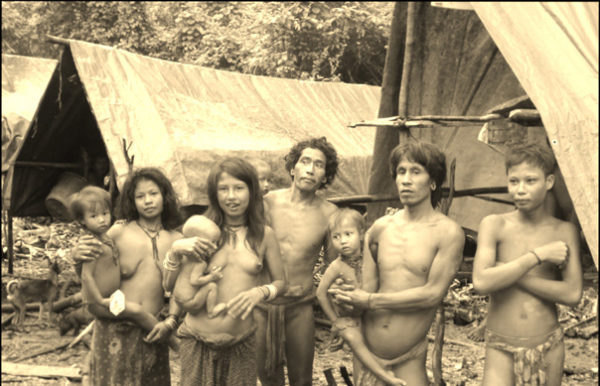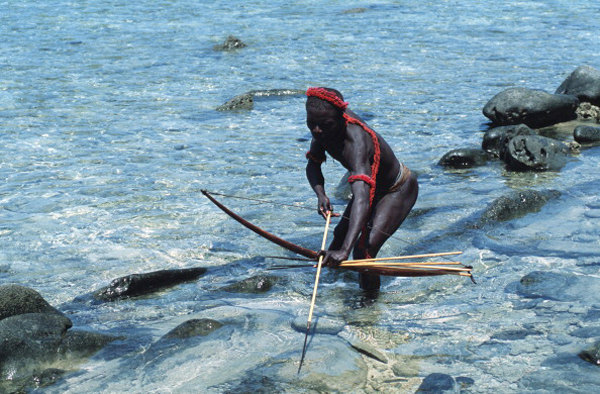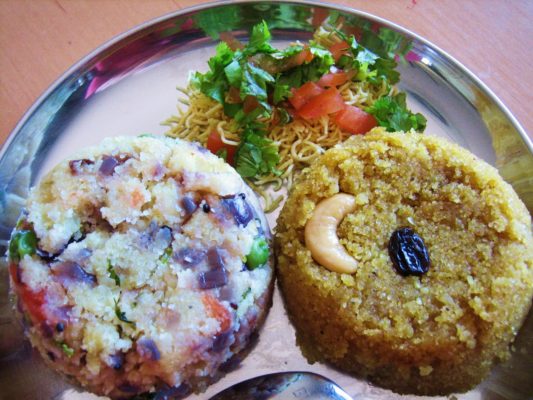Situated in the Indian Ocean, towards the southern side of India, are a group of islands known as the Andaman and Nicobar Islands. This is a part of our country not very well known, and also a part in which one is not interested until one is planning a costly vacation on the coasts. However, there is one other thing at these small pieces of land that might get you interested here; the tribes of Andaman and Nicobar Island. The people living here had been cut off from the contacts of mainland culture and the developments taking place there. As a result, the people whom you might meet here will neither look like the people of mainland India nor behave like them. Looking at them, it seems as if they are still caught up in primitive times and there, in that dimension of time, lies their unique world undisturbed by modern times.
The inhabitants of these islands are tribes of Negrito and Mongoloid origin. There are four surviving Negrito tribes living on the Andaman Islands, whereas two Mongoloid tribes living on the Nicobar Islands. It is thought that the Andaman Islands were separated from Africa and so were these Negrito tribes, about 60,000 years ago. Originally there were five Negrito tribes occupying the Andaman Islands, as discovered by the European colonists who had come to visit these islands during their reign over India. These five tribes in Andaman and Nicobar were:-
From among these five tribes, only four survive now with the Jangil tribe being extinct. The Onge and Jarawa exist in pure forms, however, less than a hundred individuals of Onge are known to be purely Onge, whereas around 250 to 400 individuals of the Jarawa tribe exist in pure form. The pure Great Andamanese are extinct now and admixed individuals belonging to the tribe are known to be alive. About only a hundred to two hundred individuals of the Sentinelese tribes are known to be alive.
The two Mongolian tribes living at the Nicobar Islands are the Nicobarese and the Shompen. Although the Nicobarese have become adapted to the change, the Shompen tribe remains unattached with the outsiders.
Though not much is known about these people, here we make a small effort to help you know about these age-old tribes who have successfully preserved their culture.
The Great Andamanese Tribe
Thought to be the descendants of the Africans, they are known to have migrated out of Africa around 60,000 years ago. They are pygmies, divided into ten major tribes. They are closely related to the other tribes of the Andaman Islands but have a different kind of culture. They were the tribe largest in number with a population estimation of about 2,000 to 6,600. They, however, suffered great losses at the hands of warfare with the European colonists who tried to dominate them. They also suffered diseases and many died during the hunting sessions. In the year 2010, only 52 of them were known to be alive. Much of their tribal and linguistic distinctions had faded off, and they emerged as a single tribe. Now they have a mixed Indian, Burmese and aboriginal culture.
Till the late 18th century they strictly avoided contact with the outside world going to the extent of killing shipwrecked foreigners. However, by the late 18th century the British reigned here. That was when it was known that they were sub-divided into ten tribes with 200 to 700 individuals in each tribe. They lived at all the Andaman Islands except Little Andaman and Rutland Island. When these regions were invaded by the British, their culture seemed to be challenged. There was a sharp decline in their population when their contacts with foreign colonists became more concentrated. Together with that, they were also affected by the diseases, introduced in their land by the outsiders, to which they had no immunity. There were cases of the tribal killing their own members because they feared that the diseases might be contagious.
After the Independence of India, their number declined further. In 1969 there were only 23 left, who were then shifted to Strait Island. Slowly their number increased. By 1995 they had many individuals boasting of partly Indian or Burmese descent.
In the current times, these Indian Tribes are supported by the Indian Government. Much of their diet includes Indian food although they still go fishing, hunting, and food gathering. They also have farms now to practice agriculture and a little bit of animal husbandry.
Jarawa Tribe
Unlike the Great Andamanese, Jarawa has stayed totally out of contact with the outside world. They have been known to exist, but since contact with them has been very less and intermittent, not much about their culture is known. They are believed to be the ascendants of the now-extinct Jangil tribe. They outnumbered the Jangil tribe, who were separated from them a long time back. They have known to have contacts only with the other Andamanese tribes.
Till the late 18th century their homeland was thought to have been located in South Andaman Island. But soon as the Great Andamanese tribe was getting wiped out, the Jarawas extended their lands. They were known to have been detached with the outsiders, but by 1998 they frequented their contacts with the foreigners making it dangerous for them, in case they caught any disease. In spite of this, they now regularly contact the outsiders, either at the places where they live or at the local markets or hospitals.
Their population has been greatly impacted by the Great Andaman Trunk road; both in positive and negative ways. They came to visit the settlements near the road and within a period of a few months, they came in contact with some dangerous but not fatal diseases. Their children now, however, go to school and are educated in the same manner as the children of the foreigners.
Soon, though, they became victims of encroachment, poaching and commercial exploitation due to which a case was filed in the Calcutta High Court which has jurisdiction over the islands. Awareness was raised and the government was ordered to take action to protect the Jarawa tribe. Tourism also impacted their survival in a great way and the court had to issue an order to the tourists, stopping them from interacting with or clicking pictures of the Jarawa tribe. The cases, however, did not stop. Soon the Calcutta High Court had to order people to stop traveling via the Great Andaman Trunk road. But there was an appeal put up by the locals claiming the road to be very important. The court had to lift its previous order, but a new order was given. According to the court now vehicles travel only in large convoys, four times a day.
Onge Tribe
Earlier inhabiting Little Andaman, Rutland Island, and the South Andaman Island, the Onge tribe inhabit only two reserve camps on Little Andaman after their population faced a decrease in number. Being semi-nomadic, they hunted for food instead of farming. Not much of their culture is known and not many of them have been known to have survived to date. A major cause of their extinction was a tsunami. After the tsunami, only 96 of the Onge individuals were left who had taken shelter on the highland of the island.
Their increasing interaction with the outsiders also impacted their population resulting in a decrease in their numbers from 672 in 1901 to 250 in 1951. Also in December of 2008, they contracted a poisoning incident where around 23 men had drunk a bottle of methanol thinking it to be alcohol. It was concluded that if any more men died then it could be dangerous for the survival of the tribe.
They are even considered to be very sterile proving to be a drawback for any chance of an increase in their number. Usually, Onge women conceive after the age of 28 where the mortality of children and infants is around 40%.
They speak what is known as the Onge language. But with increasing interaction with outsiders Onge speakers have been reduced in number. But the slight increase in their number has been noticed recently.
Sentinelese Tribe
Sentinelese tribe is the most untouched tribe of the Andaman Islands. They live on the North Sentinel Island, isolated completely from the other tribes in Andaman and Nicobar and also from the world. They are still leading the life of hunter and gatherer as they hunt and gather food, together with fishing. They also seem to have knowledge of certain beneficial plants. They don’t, however, know about how to produce fire and cook food.
Their population is not known well. It is estimated that they might be 40 to 500 in number. No one has managed to go close enough to the tribe to be able to count the number of each and every individual. The reason for this is simple. They are very hostile towards outsiders.
The British had a troupe of soldiers led to the island during their reign but no fruitful results were obtained. During their visit, the British had managed to abduct a couple and a few children. Their plan was to treat them well and to leave them back to their home with gifts. This would help them to establish a friendly relation. Later, though, they lost interest in this tribe and focused on other tribes. Since then many groups from the Indian government have been there but without any significant difference. They still respond to outsiders with hostility, shooting them with their arrows. They do not think twice before killing anyone who seems like possible harm. There was an incident, in fact, where they killed a few men who had reached their shores while fishing in their region. These men were later buried by them.
Their language has not been recognized yet. Their language does not seem much similar even to the Jarawa tribe who are their nearest neighbor. Although they have a different language, their physical characteristics are just the same as the other Negrito tribes of the Andaman Islands. They have short stature and dark skin.
This tribe also seems to be quite tough-skinned against the natural calamities. The impacts of the earthquake or tsunami have not been known if any. There also seems to be more men than women, although there might be a possibility that because their population is not accurately measured it seems that the male sex ratio is greater.
The Nicobarese Tribe
Neighboring to the Andaman Islands is the Nicobar Island. However, these two islands vary to a very great extent when we take into account their inhabitants. The Nicobarese tribe comprises of the dominant tribes of the Nicobar Islands. An alternative name that they have is Holchu which stands for ‘friend’.
They are headed by a queen, the first being Islon who was the most prominent person of the island. The men and women seem to be equally placed in society, and the women have a lot of liberty too. The Nicobarese women take care of the households and also farming.
They live in huts having dome-shaped roofs. These huts are at length above the ground and the inhabitants have to use ladders to go into the house. These ladders are pulled up at night.
All the 12 islands have different dialects, the Car Nicobar dialect being understandable to all. Their languages are a part of the Austro-Asiatic language family.
The inhabitants are mostly Christian. Christianity was propagated here by John Richardson who had read out the New Testament to them. Their traditional religion is animistic, which means they believe in spirits and ghosts. According to them, after a man dies his spirit leaves the body and becomes a ghost. They also believe that the island is surrounded by these ghosts and any unfortunate occurrences can be credited to these so-called ghosts. In such cases of unfortunate incidents, the shamans of the villagers called upon who then take care of the matter by controlling the evil spirit.
Their economy runs mainly on horticulture, where they grow plants like coconuts, pandanus, areca nuts palms, bananas, mangoes and the like. Other occupations in which they are involved include hunting, fishing, raising pigs, pottery and making canoes. And since the younger ones of the tribes are receiving free education from the government they are eligible to receive jobs of teachers and clerks among a few other job opportunities.
Shompen Tribe
The Shompen tribe is the first tribe that had arrived in the Nicobar Islands. They were already living here by the time the Nicobarese arrived here. They live on both sides of the islands; the one living on the eastern side call themselves Keyet, while the one on the western side calls themselves Kalay. They both call each other Buavela. The existence of this tribe was acknowledged in the 1840s but after India’s independence, no close contact was allowed with them. Hence, as a result, not much information is available about them.
Their approximate population of the tribe was estimated to be around 300 in 2001. After the tsunami, however, their population decreased to a great extent. Their two villages are said to have a population of only 10 and 44 individuals.
 They are the hunting-gathering type of tribe. The men wear a cloth from the waist made of bark, covering only the genital area. They also wear a necklace made of beads. The women wear a skirt and a cloth covering them from their shoulders. They use ahav or earrings, naigaak or necklaces, and geegap which are the armbands.
They are the hunting-gathering type of tribe. The men wear a cloth from the waist made of bark, covering only the genital area. They also wear a necklace made of beads. The women wear a skirt and a cloth covering them from their shoulders. They use ahav or earrings, naigaak or necklaces, and geegap which are the armbands.
They use tools like the bows and arrows, spears, fire drills, and a hatchet are the main kind of tools used by the Shompen. They hunt and gather food. Their diet includes pigs, birds and other kinds of small animals. They also eat fruits and other edible items available in the forest. They also depend on farming where they cultivate yams, roots, vegetables as well as tobacco.
Their huts are of two types, the lowlands and the highlands having different types of requirements. Each hut houses about 4 to 5 people. The ones on the lower side of the land build their houses on raised surfaces, while ones on the higher side build it on the ground. The walls of the huts are made of woven material on a wooden frame. The roofs are thatched. They cook outside their houses.
There are thought to be two different types of Shompen language, which seems to be different from the Nicobarese language. Their language is expected to be an isolated Austro-Asiatic language.
Present-Day Conditions of the Tribes in Andaman and Nicobar
Day by day the number of tribesmen is decreasing rapidly. They are getting in contact with diseases against which they have no immunity. This is, in many cases, is resulting in the death of the tribesmen. After the earthquake and the tsunami, it seems that a great number of certain tribes have been diminished. Certain other incidents, like wars, among the tribes and against each other have also led to deaths.
The Andaman and Nicobar Islands come under the Union Territories of India, and the tribes inhabiting these groups of islands come under scheduled tribes according to the Indian Constitution. Since these tribes are a heritage of our country it becomes necessary for the government to protect them. There were people employed to look after the welfare of the tribe and to help them develop. Many acts have been formulated to ensure that the tribes are safe and protected together with the facility of being able to develop. Professionals are being hired to look after the affairs of the tribes. A lot of measures are being taken up for them and hopefully, soon we will be able to see a full-fledged population of the tribes.
















A bright write up on the inhabitants of Andaman and Nicobar Islands. Government of India should preserve these tribes as much as possible and their population should increase constantly. Medical care of these tribes for immunity building is also a priority. Looking forward to visit these islands soon and perhaps if I can settle there permanently to help in preserving the world heritage.
Whats up are using WordPress for your site platform?
I’m new to the blog world but I’m trying to get started and set up my own. Do you need any coding knowledge to make your own blog?
Any help would be greatly appreciated!
Hi Amit!,
Are these photos of jarawas tribe copyright free?
hi!,I love your writing so a lot! share we communicate extra approximately your article on AOL? I need a specialist on this area to unravel my problem. May be that is you! Taking a look forward to see you.
please drop your issues at amit@realbharat.org
F*ckin’ awesome issues here. I am very happy to see your post. Thank you so much and i’m looking ahead to contact you. Will you kindly drop me a mail?
please drop me a mail at amit@realbharat.org
Muchas Gracias!
Thanks